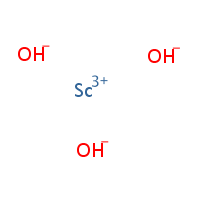CHEMICAL SUBSTANCE DATASHEET
|
CHEMICAL SUBSTANCE IDENTIFICATION |
|
|
Chemical name |
Scandium hydroxide |
|
Synonyms |
Scandium trihydroxide |
|
IUPAC name |
scandium(3+);trihydroxide [1] |
|
CAS No |
17674-34-9 |
|
REACH registration number |
on EC list ( REACH pre-registration) |
|
EC No |
241-658-0 |
|
Molecular formula |
H3O3Sc |
|
Substance group/chemical family |
|
|
Appearance Physical state Odour Form Colour |
powder [4]
white [4] |
|
USES AND HANDLING ISSUES |
|
|
Relevant identified uses |
Scandium Hydroxide is applied in optical coating, catalyst, electronic ceramics and laser industry. [4] |
|
Handling considerations |
|
|
PHYSICO-CHEMICAL PROPERTIES |
|
|
Molecular weight |
95.977 g/mol [1] |
|
Bulk density/Specific gravity |
|
|
pH |
|
|
Particle size |
|
|
EC |
|
|
Melting point |
|
|
Boiling point |
100 °C at 760 mmHg [3] |
|
Flash point |
|
|
Flammability |
|
|
Vapour density |
|
|
Vapour pressure |
24.5 mmHg at 25°C [3] |
|
Solubility in water |
|
|
Solubility in organic solvents |
|
|
Solubility in inorganic solvents |
|
|
Hydrolysis |
|
|
Ionicity in water |
|
|
Surface tension |
|
|
Dispersion properties |
|
|
Specific surface |
|
|
Stability and reactivity |
|
|
Chemical stability |
|
|
Reactivity hazards |
|
|
Corrosivity |
|
|
Polimerization |
|
|
Incompatibility with various substances |
|
|
Special remarks on reactivity |
|
|
Physical, chemical and biological coefficient |
|
|
Koc |
|
|
Kow |
|
|
pKa |
|
|
log Kp |
|
|
Henry-constant |
|
|
ENVIRONMENTAL FATE AND BEHAVIOUR |
|
|
Artificial pollution sources |
|
|
General terrestrial fate |
|
|
General aquatic fate |
|
|
General atmospheric fate |
|
|
General persistence and degradability |
|
|
Abiotic degradation and metabolites |
|
|
Biodegradation and metabolites |
|
|
Bioconcentration |
|
|
Volatilization |
|
|
Photolysis |
|
|
Hydrolysis |
|
|
Soil adsorption and mobility |
|
|
ENVIRONMENTAL CONCENTRATIONS |
|
|
Measured data |
|
|
|
|
|
ECOTOXICOLOGICAL INFORMATION |
|
|
General adverse effects on ecosystem |
|
|
Acute toxicity (LC50, EC50) |
|
|
Aquatic systems |
|
|
Terrestrial systems |
|
|
Chronic toxicity (NOEC, LOEC) |
|
|
Aquatic systems |
|
|
Terrestrial systems |
|
|
HUMAN HEALTH EFFECTS and PROTECTION |
|
|
Routes of human exposures |
|
|
General effects |
|
|
Endocrine disruption |
|
|
Mutagenicity |
|
|
Carcinogenicity |
|
|
Reprotoxicity |
|
|
Teratogenicity |
|
|
Skin, eye and respiratory irritations |
|
|
Metabolism: absorption, distribution & excretion |
|
|
Exposure limits |
|
|
Drinking water MAC |
|
|
Other information |
|
|
Animal toxicity data |
|
|
Acute toxicity (LD50) |
|
|
Chronic toxicity (NOEL, LOEL) |
|
|
ENVIRONMENTAL STANDARDS AND REGULATIONS |
|
|
EINECS regulation |
̵ |
|
OSHA regulations etc. |
|
|
|
|
|
OTHER INFORMATION, SPECIAL REMARKS |
|
|
Classification and proposed labelling with regard to toxicological data |
According to the majority of notifications provided by companies to ECHA in CLP notifications no hazards have been classified. [2] |
|
|
|
|
CREATED, LAST UPDATE |
|
|
Created |
2018. 10. 30. |
|
Last update |
2018. 10. 31. |
|
REFERENCES |
|
|
[1] Pubchem https://pubchem.ncbi.nlm.nih.gov/compound/Scandium_hydroxide#section=3D-Status, Accessed 2018.10.30 [2]ECHA, Substance information, Scandium trihydroxide, https://echa.europa.eu/substance-information/-/substanceinfo/100.037.855, Accessed 2018.10.30 [3]LookChem, Scandium hydroxide https://www.lookchem.com/Scandium-hydroxide/, Accessed 2018.10.30 [4] Prochem, Scandium hydroxide. http://www.prichem.com/product/scandium-hydroxide.htm, Accessed 2018.10.30 |
|
